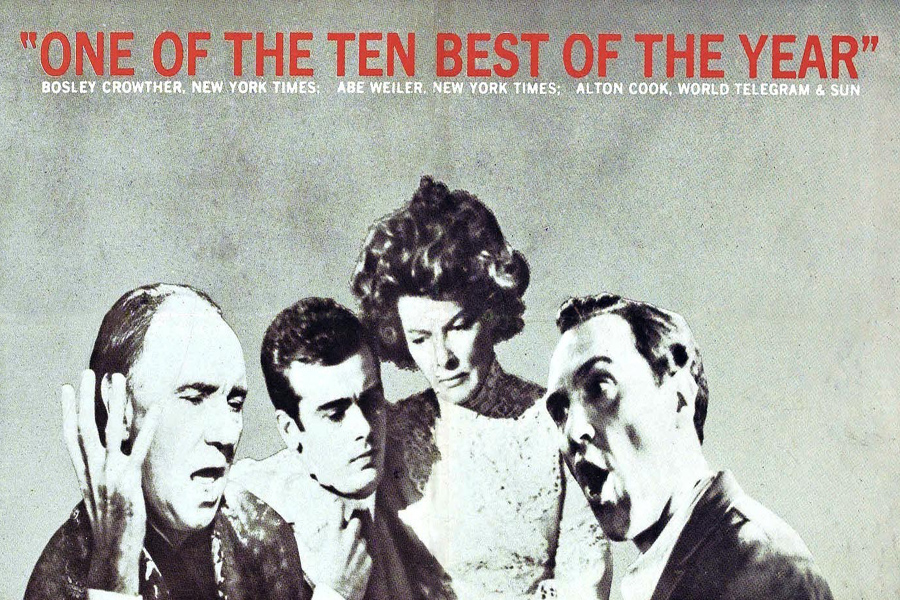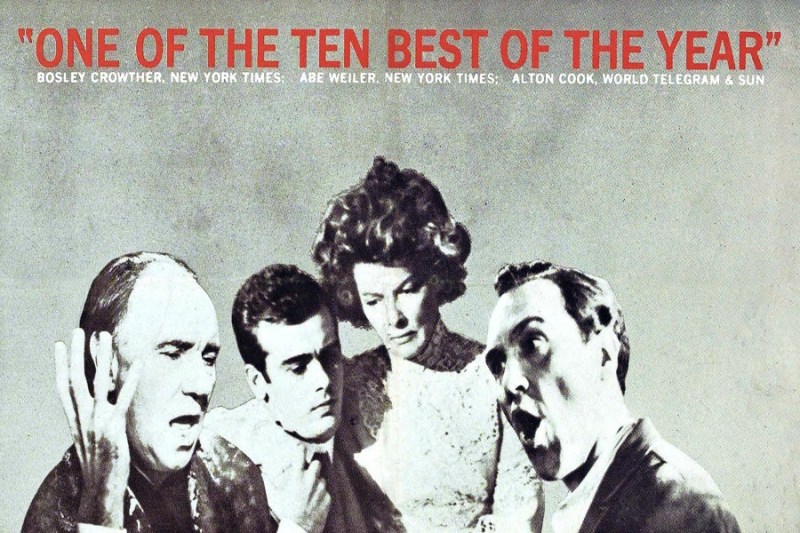
Nearing the end of my senior year (tear), I take time to reflect on the movies that have most shaped who I am as a person. This quarter, I’ll be starting a weekly column called “Recs from the Vault.” These are capsule reviews I’ve written on some of the films that have most powerfully affected me during my time here at Stanford. I’ve included their call numbers in Green Library’s Media and Microtext Center to make it easier for readers to watch these incredible works.
The Breaking Point (1950)
Warner Bros.’s and Michael Curtiz’s 1950 re-adaptation of the Ernest Hemingway novel “To Have and Have Not,” this time with two battle-worn leads (John Garfield and Phyllis Thaxter) as a lower-middle-class boating couple struggling to make ends meet. Apparently, Hemingway once said “The Breaking Point” was the greatest film adaptation of any of his works, and you can see why. Garfield is superior to Humphrey Bogart (“To Have and Have Not,” 1944) in the role of a hardboiled skipper who gets involved with shady criminals against his will — and with tragic consequences. Juano Hernandez, one of the best black actors of the late 40s and early 50s, is hypnotizing as the independent skipper who is the film’s untyped conscience. Patricia Neal as the platinum blonde has the film’s meatiest and juiciest lines, delivered with such casual grace and framed in Curtiz’s untelegraphed, deep-focus long shots. The melancholy is palpable in every scene, camera movement and character gesture: No person seems overworked, and the dialogue between Patricia Neal’s trouble dame and the troubled John Garfield skipper is much subtler than anything in the comparable “Casablanca,” also directed by Curtiz. Infuriatingly, “The Breaking Point” has never recovered from the trumped-up scandal involving John Garfield’s Communist ties that doomed it to obscurity and suppression during the McCarthy/HUAC hearings. Phyllis Thaxter’s expressive eyes should have also made her name, but alas, her star died with Garfield’s — and Garfield. (He died of heart failure only two years after “The Breaking Point,” purportedly brought upon by the stress of the HUAC hearings.) What a shame, since “The Breaking Point” is ripe for rediscovery in our times. Its existential doom is palpable (one of the best lines is transposed from a fine Hemingway film, “The Killers”: “One man alone ain’t got no chance …”). And it has perhaps the most devastating final shot in all of American cinema. What it says about America’s deeply embedded racism is honest, unrelenting and refreshingly upfront. 97 minutes. Black and white. ZDVD 41307, ZDVD 41308 BLU-RAY, ZDVD 27408.
Long Day’s Journey Into Night (1962)
Everyone is at the top of their game in Sidney Lumet’s 1962 film of Eugene O’Neill’s posthumous play (based on the playwright’s own life, struggling to support his own drug-addicted mother). It’s 1912, and everyone suffers in a New England family of artists: The father (Sir Ralph Richardson) is a boozed-out has-been of a Shakespearean, the eldest son (Jason Robards) spends his days drinking in a whorehouse, the mother (Katharine Hepburn) got addicted to dope after the painful birth of her youngest son (Dean Stockwell), a poet who has a fatal case of tuberculosis. In the course of one day, all the sutures come undone; together, they must confront their misery. Katharine Hepburn delivers one of those performances that haunts you forever, reaching astonishing heights that very few actresses of her generation could aspire to. Her natty hair, her glazed-showgirl eyes and her piercing monologues (“I was happy … for a time …”) provide the human face to every American family’s dirty little secrets. Though the film is marred by the queasiness inherent in the creation of a piece of filmed theatre (Lumet feels the need to awkwardly jam in reaction shots where they break up the flow of a monologue), the four actors provide a tearful desperation to O’Neill’s words. And when Lumet suddenly realizes he’s making a film, it soars — literally — as in the entire staging of Hepburn’s final monologue (a floating crane-like camera that shrinks the house to make the people look puny and insignificant vs. bulging close-ups of the tired suspects so that we understand their individual traumas — a great dichotomy of distance). Andre Previn’s haunting, atonal piano score is a highlight. In a rare sweep, all four of the principals won the Best Actor and Best Actress awards at the 1962 Cannes Film Festival. Katharine Hepburn was nominated for a Best Actress Oscar, losing to Anne Bancroft in “The Miracle Worker.” 174 minutes. Black and white. ZDVD 29053, ZDVD 29048 BLU-RAY. Also on YouTube.
Kiss Me, Stupid (1964)
A cynical takedown of marriage, a celebration of human frailty and Billy Wilder at his sunny gloomiest. As is typical of a comedy script by Wilder and I.A.L. Diamond (they wrote “The Apartment” and “Avanti!”), summarizing the film is a hopeless effort, for it’s a labyrinthine plot that must unfold before you to be admired. At the start, I was bracing myself for a mediocre Billy Wilder comedy. It’s not talked about as much as other Wilders (“Sunset Blvd.”, “Some Like it Hot”), and Wilder later disowned it. By the end, I was sold and hooked. Why would any artist turn their back on such a glorious work? The women (Kim Novak and Felicia Farr) are the clear highlights. Dean Martin plays an unsavory version of himself. Ray Walston amazingly, gradually, soars; despite the fact that (or rather, because) he is so pencil-necky and unlikeable, he is perfect for the role of the hen-pecked husband. (Jack Lemmon and Peter Sellers, whom Wilder preferred to play the husband, would have been way too charming.) But the most stunning performance is from Kim Novak as the waitress-prostitute Polly the Pistol. With her tender eye-flutters alone and her heart-to-hearts with Felicia Farr, she shows she’s doing much more than just a Marilyn Monroe impersonation. Her performance gives the film existential stakes. It would make a killer double-feature with Hitchcock’s “Vertigo,” two films where Kim Novak is doubled, and she must navigate the tricky grooves of an increasingly fractured personality. Everything builds, and by the end, each new plot twist is giddier than the last. The film was condemned by the Catholic League of Decency — and you can see why, even if Wilder perversely calls it “the most bourgeois picture I ever did.” It’s much less stuffy than that, Billy. The dramatic string score is Andre Previn’s; all the corny songs are actually from the reject pile of George and Ira Gershwin. 125 minutes. Black and white. ZDVD 34814, ZDVD 35145 BLU-RAY.
Petulia (1968)
A bottomless pit of insight, truth and ruin. Richard Lester shot this aching 1968 melodrama during the Summer of Love in San Francisco. The film is ostensibly about the love affair between two doomed metropolitans, a bored surgeon (George C. Scott) and a flirty socialite looking for meaning in modernity (Julie Christie). But the film slowly escapes the two stars and becomes more about the incomprehensibility of the 1960s, the incoherence of the citizens who claw at each other, forming only the most basic of “communities” in a strange place. The editing is fragmented, and the story is told out of order: It starts in the middle of the affair, moving forward to the bloody end, whilst flashing back to the torrid beginning. With each new viewing of “Petulia” the hard-to-follow story keep peeling off and off like an onion with no center. At the core is a hole big enough to fill the lost souls of Petulia and Archie; a kooky woman turns numb, and a numbed man turns into a kook. It’s Lester’s most effective drama, my favorite of his astonishing run of 1960s films (which include his two Beatles films, “A Hard Day’s Night” and “Help!”). With Joseph Cotton. The ravishing color cinematography is by Nicolas Roeg (who would become a crucial 1970s auteur himself). Music by John Barry. 105 minutes. ZDVD 12326.
Killer of Sheep (1977)
Charles Burnett’s neorealist masterpiece of Watts, Los Angeles in the late 1970s. A black family is led by the stoic, slaughterhouse-worker-patriarch Stan (Henry G. Sanders), his unemployed wife (Kaycee Moore) and their two children, a quiet girl and a playful boy. The memory of Watts ’65 hangs over each scene; the smoke may have dissipated, but the pain and the desperation have not. Every cut in “Killer of Sheep” is a new truth being staked out for the first time in fresh cinematic terms. When he interposes the yakking of a black man whose tire has blown out over the instrumental breaks of Louis Armstrong’s “West End Blues”, Burnett demonstrates his firm belief in spirituality of a mysterious source; there’s poetry in every black soul, Burnett says. We all speak, live and breathe jazz; we’ve just never been reminded to such poetic heights. (Buried in the special features is the essential “When it Rains”, Burnett’s 1995 short about jazz, griot and the blues.) A crucial film of the L.A. Rebellion, a series of films revolving around the lives of black people in Los Angeles in the late 20th century and which include Julie Dash’s “Illusions,” Haile Gerima’s “Bush Mama” and Larry Clark’s “Passing Through.” It’s a seemingly inconsequential detail, but the moment where Stan’s son pours endless heaps of cane sugar on his Corn Flakes pierced me with such an emotional force that I had no choice but to quietly recede into my childhood memories in a stream of tears. 80 minutes. Black and white. ZDVD 16033.
La Ciénaga (2001)
Ennui has rarely been so sensually evoked as in Lucrecia Martel’s 2001 debut about a rotting bourgeois family in Argentina. She made one of the most narratively disjointed and off-kilter cinematic experiences I’ve ever endured. Lurching between mind-numbing listlessness and unprovoked action, Martel termite-eats her way through the doldrums of life. The picture is mostly a family waiting around their pool in the sticky summertime, waiting for something, anything to happen. It is constantly on the precipice of turning into a David Lynch nightmare, which it does so casually. Characters are so hush-hushed in Martel’s world that we can’t tell who’s who and how people are related to one another. And this is to say nothing of the sound, which redefines what it means to create cinematic atmosphere. As Martel says, filmmakers who don’t think about sound work within the illusory two-dimensions of the screen. Filmmakers who do (such as Jacques Tati, David Lynch, Andrei Tarkovsky and Martel) realize the ability of cinema to use the full senses, to drown the spectator in self-awareness of the space around them — all to achieve various states of reverie. For Tati, it’s humanist comic freedom. For Lynch, it’s surrealist skin-crawling terror. For Martel, it’s the essence of the unheralded ripples of life itself, the dull moments where no action happens — and when static horror sneaks in. What a brave filmmaker to work exclusively in this domain. 101 minutes. Color. ZDVD 34702 BLU-RAY, ZDVD 34701.
Contact Carlos Valladares at cvall96 ‘at’ stanford.edu.
